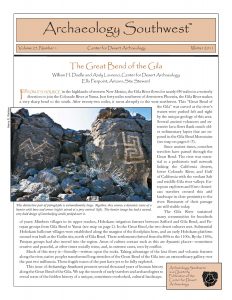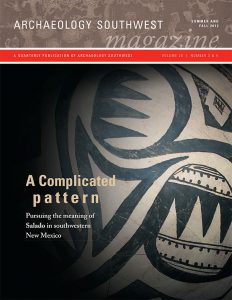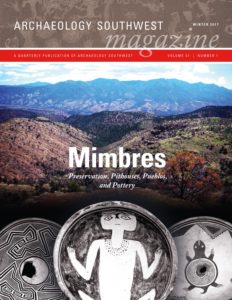Explore additional content related to Protected Places: Archaeology Southwest’s Conservation Properties and Their Emerging Roles in Preservation Archaeology, John R. Welch’s January 5, 2021, Archaeology Café Online presentation.
Extended Q&A with John Welch
Q: What’s the timeframe for occupation of these sites?
A: Different for each site! The majority of the archaeological values in our preserves were created from about 1100 to 1350.
Q: There are so many sites in San Juan & Rio Arribo Counties of NW New Mexico, many that few people know about. I’ve seen so many sites that looked like long term campsites it makes me believe some small tribes were nomadic. I would see tree trunks that were obviously chopped with a bowl shape left in the stump. I think they were chopped that way to catch precipitation also because many would be up on top of mesas. These sites are mostly on BLM land and there is very little archaeological activity, wouldn’t you like to do a planned dig on these sites to learn more, if so why not? I have also seen on the surface obviously man made dwellings and would love to dig these up to learn something about the people.
A: Sounds fascinating! Our Preservation Archaeology mission means that we strictly limit our excavations to sites that have already been damaged or are in harm’s way. When excavations are undertaken, we use methods that minimize site alteration while maximizing the information obtained.
Q: Dear Sir, Could you please give your feelings on amateur archaeologists? I’ve studied the writings of Dr. Bonnie Pitblado, University of Oklahoma, who advocates for amateur archaeologists. I am a collector on a small, private piece of property I own in Colorado I call the “workshop.” I use GPS and try to use science. Anyway, I’d like to know your concerns.
A: Dr. Pitblado is a fine archaeologist and a leader in this important domain of our discipline. We at Archaeology Southwest have the privilege of working with many highly principled collectors and dedicated private scholars. As professional archaeologists, our ethical principles limit our ability to work on projects or collections that do not end up in the public domain. Both the information and the objects we study must have “homes” in public repositories. Let us know if this answers your question.
Q: As a holder of CEs, yet an archeological non-profit, is ASW required to be certified by the Land Trust Alliance, like other Land Trusts?
A: We are required to, but we are a member of LTA, and have insurance on all our properties in order to enforce easements, if necessary.
Q: Could you say a little about what “fee simple” and “conservation easement” mean in practical terms?
A: Addendum to live answer (see video): Fee simple ownership includes few specific responsibilities and many rights, including rights to alter, transfer, and even degrade the land and resources. For those who hold conservation easements, the emphasis is on responsibilities rather than rights: responsibilities to monitor properties and defend against any action that threatens the reason the properties have been placed in conservation status. Check out our fact sheet on conservation easements.
Q: To what extent has legislation like state unmarked burial laws hopefully stopped the days when sites could be held “hostage” for private or corporate looting?
A: Good question, in part because the answers vary from region to region. In some parts of the Southwest the sheriffs ignore state laws and the pillaging continues. Please be on the lookout and let us know if violations are observed.
Q: Do you do tours of the sites and could you tell us about upcoming tours?
A: Tours are on hold for the time being. We will keep you posted.
Q: How do you engage Tribal Communities in archaeological excavation projects?
A: We invite all tribes with regional or site affinites to advise and participate in all phases of any planned excavations. We find that these consultations are extremely useful for fine-tuning our research designs, our methods, and our appreciation for site contexts.
Q: You mentioned Google Earth doesn’t update as frequently as you might wish in order to monitor the properties. Have you considered using a commercial satellite imagery service such as DigitalGlobe to source periodic images of the sites? Also, have you looked into machine learning in order to automatically detect changes in images of the sites?
A: Another good question. Yes, we have, but it sounds like you might be able to advise us. We have learned that satellite imagery only works for some sites, is quite expensive, and does not really help identify looter’s holes (only vehicles and heavy equipment activity). What are we missing? I would be grateful to have your guidance, assistance. My email is jwelch@archaeologysouthwest.org.
Extended Content:
Read Archaeology Southwest Magazine (Vol. 25, No. 1), “The Great Bend of the Gila,” available as a free PDF download, here.

Read Archaeology Southwest Magazine (Vol. 26, Nos. 3 & 4), “A Complicated Pattern,” available as a free PDF download, here.

Read Archaeology Southwest Magazine (Vol. 31, No. 1), “Mimbres Preservation, Pithouses, Pueblos, and Pottery,” available as a free PDF download for members of Archaeology Southwest, here.

See also:
- What is Preservation Archaeology? Vol. 25, No. 4 and Vol. 26, No. 1 (Fall 2011/Winter 2012)
- Preserving Archaeological Landscapes. Vol. 19, No. 3 (Summer 2005)
- Fact sheet: Who or What Is Mimbres?
- Fact sheet: Who or What Is Chaco?
- Fact sheet: Who or What Is Salado?
- Fact sheet: Protecting Heritage on the Land: Archaeological Conservation Easements
- Webpage: Places We Protect
- Video: The Future of Preservation Archaeology
Explore more with John R. Welch:
To stay informed about future online presentations and video releases, join our email list below:
Sign up for emails